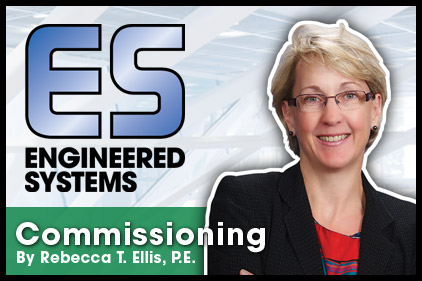HVAC systems continue to be the most challenging part of a new construction project to get right the first time, and the most challenging parts of the HVAC systems are their controls. I believe there are two root causes.
- HVAC systems require integration, coordination, and cooperation between the greatest number of individual project team members.
- HVAC systems are a main focus of today’s energy-conscious designs and their control systems are deliberately complex in order to meet the owner’s project requirements with the least amount of energy consumption.
Intra-project team member communication and coordination (#1 above) has been a recurring theme in my columns. This month, I would like to address the level of review and coordination that needs to be focused solely on the HVAC controls during the construction phase in order to improve the chances of the control systems performing as required when functionally tested during the acceptance phase.
The following are three critical topics to be worked out between multiple project team members and the recommended timing for each.
Device Coordination
For every hardware control point (sensors, switches, dampers, valves, etc.), roles and responsibilities should be spelled out during the submittal review period at the beginning of construction. The responsibilities to be defined include at least the following: 1) furnishing the device, 2) installing the device, 3) wiring the device.
I am currently in the post-construction phase of a project where a critical airflow measuring station is clearly required, but each team member assumed someone else was responsible for it. This would have been easy to figure out a year ago and quite painful to do so now after the building is occupied and expected to be providing differential airflow pressure control.
On-Board Controller Integration With The Central BAS
Which controller (on-board or BAS) is responsible for the logic, scheduling, and setpoint adjustment associated with a particular piece of equipment and/or system? Once that is established, what control points are shared between the two controllers? What on-board controller points are to be displayed on the central BAS graphics? Refer to my September, October, and November 2012 columns for more specifics on this topic.
This coordination work should ideally occur immediately following submittal approval of major equipment with on-board controllers and prior to the submission of the BAS submittal.
Control Programmer Interpretation Of Design Engineer’s Sequences Of Operation
There is probably no such thing as a perfect HVAC system control sequence. We see some specified sequences of operation that are so sparse on details that most everything is left up to the controls contractor’s preference, best judgment, or what was done on the last job. On the other end of the spectrum we see sequences that are unnecessarily verbose, repetitive, and/or contradictory, guaranteed to induce a headache when trying to figure out the designer’s intent.
From a commissioning perspective, the thing that matters most is understanding how the controls contractor will actually program the sequences and having the design engineers agree it is okay. That is the intended purpose of the controls submittal, i.e., an opportunity for the contractor to feed back to the designer the contractor’s interpretation of the specification requirements for approval prior to proceeding into implementation. However, when the controls contractor simply cuts and pastes the designer’s specified sequences of operation into their submittal, red flags should start to wave.





